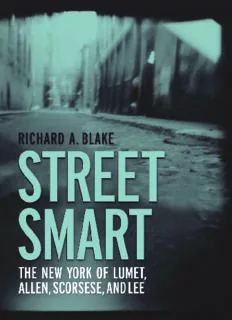
Street smart the new york of lumet allen scorsese and lee PDF
Preview Street smart the new york of lumet allen scorsese and lee
Prologue i Street Smart i This page intentionally left blank Prologue iii RICHARD A. BLAKE STREET SMART THE NEW YORK OF LUMET, ALLEN, SCORSESE, AND LEE The University Press of Kentucky iv Prologue Publication of this volume was made possible in part by a grant from the National Endowment for the Humanities. Copyright © 2005 by The University Press of Kentucky Scholarly publisher for the Commonwealth, serving Bellarmine University, Berea College, Centre College of Kentucky, Eastern Kentucky University, The Filson Historical Society, Georgetown College, Kentucky Historical Society, Kentucky State University, Morehead State University, Murray State University, Northern Kentucky University, Transylvania University, University of Kentucky, University of Louisville, and Western Kentucky University. All rights reserved. Editorial and Sales Offices: The University Press of Kentucky 663 South Limestone Street, Lexington, Kentucky 40508–4008 www.kentuckypress.com All photographs are courtesy of Jerry Olingher’s Movie Materials Store in New York, N.Y. 09 08 07 06 05 5 4 3 2 1 Library of Congress Cataloging-in-Publication Data Blake, Richard Aloysius. Street smart : the New York of Lumet, Allen, Scorsese, and Lee / Richard A. Blake. p. cm. Includes bibliographical references and index. ISBN 0-8131-2357-7 (alk. paper) 1. New York (N.Y.)—In motion pictures. 2. Lumet, Sidney, 1924—Criticism and interpretation. 3. Allen, Woody—Criticism and interpretation. 4. Scorsese, Martin—Criticism and interpretation. 5. Lee, Spike—Criticism and interpretation. I. Title. PN1995.9.N49B63 2005 791.43’627471—dc22 2005007622 This book is printed on acid-free recycled paper meeting the requirements of the American National Standard for Permanence in Paper for Printed Library Materials. Manufactured in the United States of America. Member of the Association of American University Presses Prologue v Contents Acknowledgments vii Prologue ix Cinema City: All Around the Town 1 Lower East Side: Sidney Lumet 41 Flatbush: Woody Allen 101 Little Italy: Martin Scorsese 153 Fort Greene: Spike Lee 209 Epilogue 281 Notes 289 Bibliography 303 Index 307 Illustrations follow page 144 This page intentionally left blank Prologue vii Acknowledgments A special note of thanks is due to several colleagues at Boston College. First of all, thanks to John Michalczyk who, as department chair and founder of the Film Studies program within the Fine Arts Department, urged completion of this project and by creative accommodation made it possible. With his support I was able to obtain a generous grant from the Boston College university research fund that enabled me to secure professional assistance to complete the manuscript preparation. Thanks too to Karen Klein McNulty, Mark Caprio, Eugenie M’Polo, Coleen Dunkley, and their student assistants in the Media Center who managed to locate the films and make them available as needed. Finally, a note of appreciation to the students of the two classes who took a preliminary tour of New York City neighborhoods in American Direc- tors, FM 389, and who asked the important questions, as tourists often do. vii This page intentionally left blank Prologue ix Prologue Over a week had passed since the collapse of the World Trade Center. The afternoon of September 11, I managed to contact a cousin who lives in our old neighborhood in Brooklyn but works near Ground Zero. (I’ll call her Jean, even though it isn’t her name.) She was safe. In fact, while running a bit late that morning, she heard a confused news bulle- tin on the radio about a fire in the area and further postponed her de- parture to avoid the possible inconvenience of a subway delay. Within minutes of the initial news flash, television pictures began to reveal the extent of the horror. Our conversation that afternoon was hushed and monotone, like mourners gathered at a funeral, wanting to strengthen each other but finding our words hopelessly inadequate, empty. During the next few days, we lost contact. The phone company temporarily rerouted its ruined lines from commercial centers near the disaster area through residential sections in Brooklyn. As a result, the circuits in some neighborhoods became hopelessly overloaded, and some areas were virtually inaccessible to outside callers. My initial anxiety about Jean’s safety gave way to worry about her coping with the trans- figured geography of her life. After a week or more had passed, workers toiling day and night gradually managed to restore service. By the time we spoke again, the merciful numbness was beginning to wear off as we, like most Ameri- cans, started to feel the pain of the wound that had not yet begun to heal. Our voices seemed more brittle and our sentences more edgy. Jean described her persistence in calling coworkers and her relief in learning that no one from the office had been injured. Their building was still standing, with apparently only minor damage, but of course the area ix
Description: